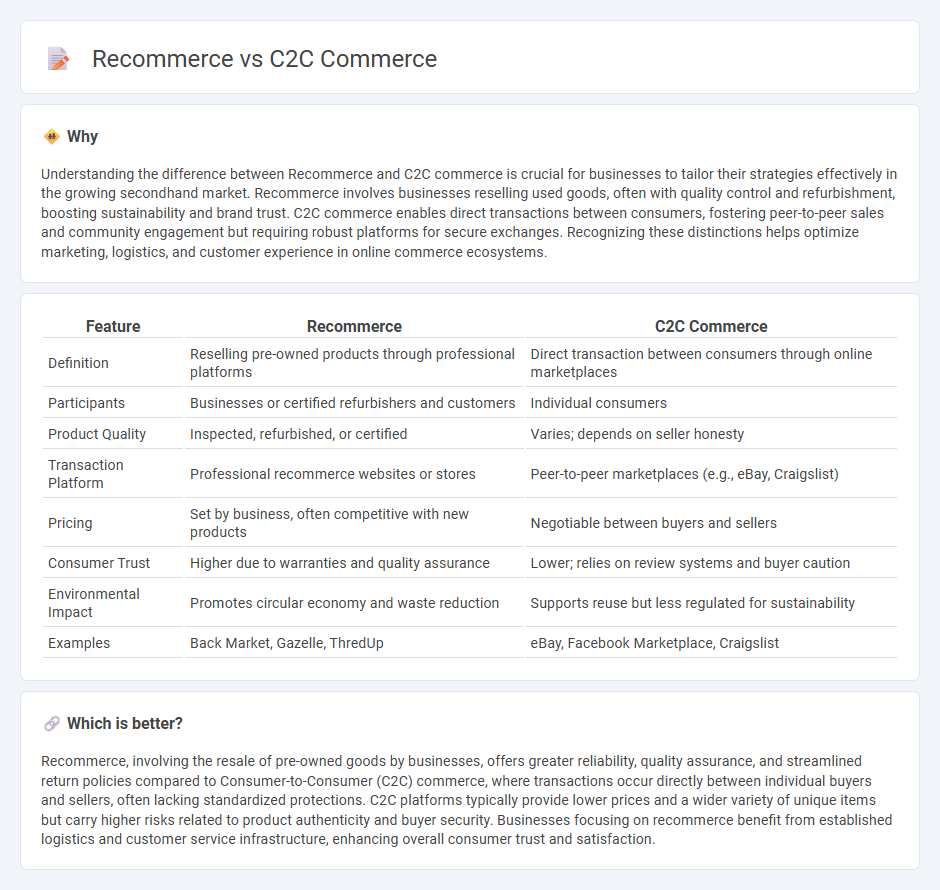
Recommerce focuses on the resale of pre-owned goods through businesses that refurbish, certify, and sell products, ensuring quality and reliability for consumers. C2C commerce enables direct transactions between individual consumers, often facilitated by online marketplaces that connect sellers and buyers. Explore how these distinct models shape consumer behavior and sustainability in modern commerce.
Why it is important
Understanding the difference between Recommerce and C2C commerce is crucial for businesses to tailor their strategies effectively in the growing secondhand market. Recommerce involves businesses reselling used goods, often with quality control and refurbishment, boosting sustainability and brand trust. C2C commerce enables direct transactions between consumers, fostering peer-to-peer sales and community engagement but requiring robust platforms for secure exchanges. Recognizing these distinctions helps optimize marketing, logistics, and customer experience in online commerce ecosystems.
Comparison Table
| Feature | Recommerce | C2C Commerce |
|---|---|---|
| Definition | Reselling pre-owned products through professional platforms | Direct transaction between consumers through online marketplaces |
| Participants | Businesses or certified refurbishers and customers | Individual consumers |
| Product Quality | Inspected, refurbished, or certified | Varies; depends on seller honesty |
| Transaction Platform | Professional recommerce websites or stores | Peer-to-peer marketplaces (e.g., eBay, Craigslist) |
| Pricing | Set by business, often competitive with new products | Negotiable between buyers and sellers |
| Consumer Trust | Higher due to warranties and quality assurance | Lower; relies on review systems and buyer caution |
| Environmental Impact | Promotes circular economy and waste reduction | Supports reuse but less regulated for sustainability |
| Examples | Back Market, Gazelle, ThredUp | eBay, Facebook Marketplace, Craigslist |
Which is better?
Recommerce, involving the resale of pre-owned goods by businesses, offers greater reliability, quality assurance, and streamlined return policies compared to Consumer-to-Consumer (C2C) commerce, where transactions occur directly between individual buyers and sellers, often lacking standardized protections. C2C platforms typically provide lower prices and a wider variety of unique items but carry higher risks related to product authenticity and buyer security. Businesses focusing on recommerce benefit from established logistics and customer service infrastructure, enhancing overall consumer trust and satisfaction.
Connection
Recommerce and C2C commerce intersect through their focus on the resale and exchange of pre-owned goods, facilitating sustainable consumer behavior and reducing waste. Platforms like eBay and Poshmark enable peer-to-peer transactions, optimizing product lifecycle value and promoting circular economy principles. This synergy drives economic efficiency by leveraging digital marketplaces that connect individual sellers and buyers directly.
Key Terms
Peer-to-Peer (P2P)
C2C commerce centers on direct peer-to-peer transactions where individuals buy and sell goods or services without intermediaries, fostering a decentralized marketplace. Recommerce involves reselling used or pre-owned products, often through platforms that facilitate P2P exchanges, emphasizing sustainability and circular economy principles. Explore how these models transform consumer behavior and drive sustainable growth in the digital marketplace.
Resale
C2C commerce involves direct transactions between consumers, typically through online marketplaces like eBay and Facebook Marketplace, facilitating peer-to-peer resale of goods. Recommerce emphasizes the resale of pre-owned products through professional platforms such as thredUP and Gazelle, often incorporating quality control and refurbishment to ensure product reliability. Explore the growing impact of resale markets and how they drive sustainable consumer habits.
Online Marketplace
C2C commerce involves direct transactions between consumers on online marketplaces where individuals sell new or used goods to each other, leveraging platforms like eBay and Facebook Marketplace. Recommerce focuses specifically on the resale of pre-owned or refurbished products, emphasizing sustainability and circular economy principles through specialized platforms such as thredUP and Gazelle. Explore how these marketplace models transform shopping habits and drive eco-friendly consumption.
Source and External Links
What is C2C eCommerce? Benefits, Example & How it Works - C2C eCommerce is a business model where individuals trade products or services directly through online platforms that facilitate listings, payments, and dispute resolution, eliminating intermediaries and allowing peer-to-peer transactions with prices set by sellers and reputation systems to build trust.
Pros and Cons of a C2C eCommerce Business Model - C2C platforms act as virtual marketplaces enabling consumers to sell directly to one another, increasing profitability for sellers by removing intermediaries and lowering costs such as store rent and staff salaries, with examples including eBay, Etsy, and Facebook Marketplace.
Understanding the C2C Market: Benefits, Types and Challenges - C2C is a consumer-to-consumer business model facilitating transactions via third-party platforms, allowing private sellers to connect with buyers through online auctions, e-commerce sites, or social media, promoting affordability, convenience, and sharing economy benefits.
 dowidth.com
dowidth.com